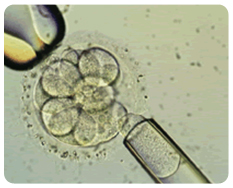
Couples at high risk of transmitting an inherited disease to their offspring, have the option of undergoing prenatal diagnosis to allow the detection of the genetic disorder in fetus. However, if the analysis reveals a genetically affected fetus the only options available to couples are to have a child with a genetic disease or to terminate the affected pregnancy. This is a difficult and often traumatic decision, especially in advanced pregnancies.
Many couples may also experience repeated pregnancy terminations in attempts to conceive a healthy child and might feel unable to accept further affected pregnancies. In some cases this may also not be a viable option for religious or moral reasons.
Preimplantation genetic diagnosis (PGD) has been introduced as an alternative to prenatal diagnosis, to increase the options available for couples who have a known genetically transmittable disease, providing reassurance and a reduced anxiety associated with reproduction. PGD can be considered as a very early form of prenatal diagnosis. Its intended goal is to diagnose a specific genetic disease on oocytes or embryos before a clinical pregnancy has been established, by selecting and transferring to the uterus only embryos resulted unaffected after mutation analysis. Consequently, PGD may spare the couple decisions regarding possible pregnancy termination, ensuring a pregnancy free of the disease under consideration.
PGD usually requires that the couple undergoes to an in vitro fertilization (IVF) treatment. This involves hormonal treatments that allow the collection of multiple eggs from the mother. The eggs are then fertilized using the father’s sperm and the resulting embryos are transferred to an incubator. After three days the embryos usually consist of a tiny ball of eight cells, known as blastomeres. To test the blastomere, an opening is made in the covering of the embryo. One or two blastomeres are then removed (biopsied) from each embryo and subjected to genetic testing. If a blastomere is found to be unaffected by the inherited disease then the embryo that it was removed from will also be unaffected. Embryos that are revealed to be healthy can be transferred to the womb, ultimately producing unaffected babies.
Testing of the biopsied cells destroys them because their membranes must be broken open to release the DNA. As such, one cannot use them for any other purpose or return them to the embryo.